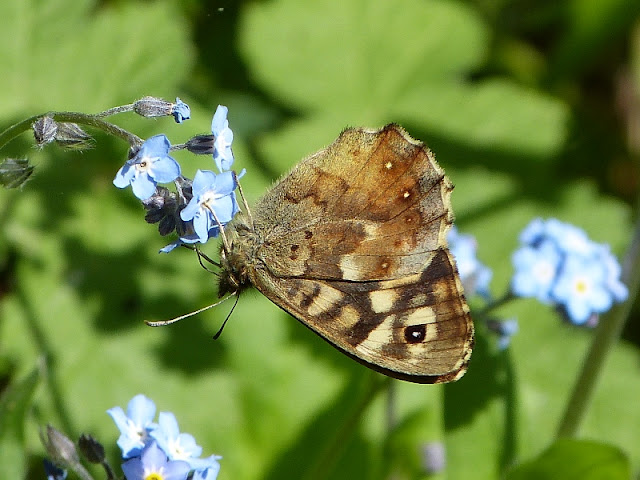I have been looking back at the butterfly records for all species recorded here over the last five years and then comparing the 2017 figures with the average figures for that period. In the graph below the average number of Speckled Woods recorded over the last five years is shown in blue, with the 2017 records shown in red.
You will see that Speckled Woods did exceptionally well in the spring, but the poor weather in June and July impacted on their numbers. However, they made a bit of a resurgence later in the year.
Speckled Woods are interesting in that they can spend the winter as either a caterpillar or chrysalis. Those that we see here in April and May are thought to have spent the winter as a chrysalis. The larger peak in population from mid-June to mid-July are those that spent the winter as a caterpillar. There is usually then a much bigger second generation later in September.
Looking further back, the number of Speckled Woods recorded in East Lothian has shown a steady increase since they were first recorded in 2009. 2014 was a very good year for many species, and Speckled Woods did particularly well then, but even with the poor start to the summer we had in 2017 they did better than ever.
Year
|
No
of
Speckled
Woods
|
2009
|
2
|
2010
|
1
|
2011
|
16
|
2012
|
11
|
2013
|
134
|
2014
|
1019
|
2015
|
465
|
2016
|
692
|
2017
|
1174
|
I have been mapping where Speckled Woods have been recorded and the previous maps are shown on my earlier post. This year the Speckled Wood has continued to spread and it can now be assumed it occurs anywhere there is suitable habitat in East Lothian.
It is interesting that in a year when many species of butterflies have done so badly, this species has done well. The new arrivals in East Lothian appear to be getting on better than many of the species that have occurred here for many years.




Certainly a species that is doing well Nick. Love them 2 shots!
ReplyDeleteBrian,
DeleteIt is great that they are doing so well. Just a shame that other species seem to be struggling.
What is needed is a couple of 'normal' years weather so numbers can recoup, and a lot more conservation research.
DeleteYes, definitely. That is three cool, cloudy summers in a row. I am sure that has an impact. One poor year and they can bounce back, but after three I think they are struggling. I was just looking through my butterfly records from 2001, when I was a countryside ranger on the coast. They make an interesting comparison with recent records.
DeleteThey are doing well! That last shot is my favorite.
ReplyDeleteThanks Michelle.
DeleteThis is great to hear Nick. Makes me think of the host plants for the larvae. Do you think the increase may be due to an abundant availability of host plants? Or do you think it’s their capacity to withstand winter as either chrysalides or caterpillars?
ReplyDeleteHi Maria. The foodplant is common grasses, which have always been here. In fact there are records of the Speckled Wood occuring here in the 1700s. They disappeared in the early 1800s after a series of cold winters, sometimes referred to as a little ice age. So,it would appear that they are moving north in response to climate change.
DeleteGood morning Nick!:) What hardy butterflies they are, and long may their wide spread population continue. They seem to be thriving on your native grasses. Fingers crossed for better summer weather this year, so that all species do well. Many thanks for your helpful ID of the Osprey. :)
ReplyDeleteHi Sonjia,
DeleteYes, we deserve to have a good summer and the butterflies really need a decent season. I hope that Speckled Woods are continuing to do well in Portugal.
Oh i can only wish to have here butterfly researches like those. But at present most of government funds for agriculture are devoted to food and related subjects. Even ornamentals suffer from negligence because they are not directly consumed. Sigh! the conditions in poor countries or probably unmanaged resources!
ReplyDeleteAndrea, all of this work is undertaken by volunteers who send their records to me. I am also working as a volunteer and do it for the love of the subject. We are lucky to have a UK-side charity that we supply our information to along with many other volunteers from around the country. It is probably not much more than you and your fellow Philippine Lepidoptera friends do.
Delete